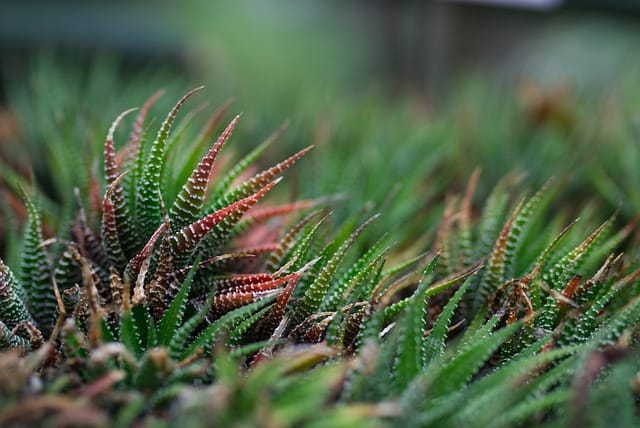How to grow Haworthias
Haworthias are a popular choice for indoor plant enthusiasts, thanks to their unique appearance and low maintenance requirements

In this article:
- Introduction
- Overview of Haworthias
- Choosing the Right Haworthia Species
- Ideal Growing Conditions
- Selecting the Appropriate Container
- Potting Mix and Repotting
- Watering Needs
- Sunlight Requirements
- Temperature and Humidity Considerations
- Fertilizing Haworthias
- Pruning and Propagating
- Common Pests and Diseases
- Preventive Measures
- Tips for Maintaining Healthy Haworthias
- Frequently Asked Questions
- Conclusion
Introduction
Haworthias are a popular choice for indoor plant enthusiasts, thanks to their unique appearance and low maintenance requirements. In this article, we will provide you with a comprehensive guide on how to successfully grow and care for Haworthias in an indoor setting.
Overview of Haworthias
Haworthias belong to the succulent family and are native to Southern Africa. These plants are known for their rosette-shaped leaves, which can come in various patterns and textures. Haworthias are small in size and usually do not exceed a few inches in height.
Choosing the Right Haworthia Species
There are numerous species and varieties of Haworthias available in the market. When selecting Haworthias for indoor cultivation, consider factors such as size, growth habits, and leaf characteristics. Some popular species to consider are Haworthia retusa, Haworthia cooperi, and Haworthiopsis attenuata.
Ideal Growing Conditions
Haworthias thrive in bright, indirect light conditions. They prefer temperatures between 65°F and 80°F (18°C - 27°C) during the day, and slightly cooler temperatures at night. In terms of humidity, they can tolerate average indoor humidity levels without any issue.
Selecting the Appropriate Container
Choose a container with drainage holes to ensure proper water drainage. Haworthias are adapted to grow in shallow pots as their roots are relatively shallow. A pot with a diameter of about 4-6 inches should be sufficient for most Haworthia species.
Potting Mix and Repotting
Use a well-draining cactus or succulent potting mix for your Haworthias. Avoid heavy, moisture-retaining soils as they can cause root rot. Repot your Haworthia every 2-3 years or when you notice it has outgrown its pot.
Watering Needs
Haworthias are drought-tolerant plants. Water your Haworthias thoroughly, allowing the soil to dry out between watering sessions. Be cautious not to overwater as it can lead to root rot. During the winter months, reduce watering frequency as the plants go through a dormant period.
Sunlight Requirements
Haworthias prefer bright but indirect sunlight. A north or east-facing window sill is an ideal location for them. Avoid placing them in direct sunlight for extended periods as it can scorch their leaves.
Temperature and Humidity Considerations
Haworthias can tolerate a wide range of temperatures but prefer moderate conditions. Maintaining a temperature range of 65°F to 80°F (18°C - 27°C) is beneficial for their growth. Average indoor humidity levels are generally sufficient for their needs.
Fertilizing Haworthias
Fertilize your Haworthias sparingly during the growing season, which typically falls between spring and summer. Use a balanced, water-soluble fertilizer diluted to half the recommended strength. Avoid fertilizing during the winter months when the plants are not actively growing.
Pruning and Propagating
Dead or decaying leaves should be removed regularly to maintain the plant's overall health. Haworthias can be easily propagated through offsets or leaf cuttings. Allow the cuttings to callous for a few days before planting them in a well-draining soil mix.
Common Pests and Diseases
Haworthias are generally resistant to pests and diseases. However, they can occasionally be affected by mealybugs or aphids. If you notice any signs of infestation, isolate the affected plant and treat it with an appropriate insecticide or use natural remedies like neem oil.
Preventive Measures
To prevent pest infestations and diseases, ensure good air circulation around your Haworthias. Avoid overwatering and maintain proper hygiene in your growing area. Regularly inspect your plants for any signs of stress or problems and address them promptly.
Tips for Maintaining Healthy Haworthias
- Avoid placing your Haworthias in extremely hot or cold locations.
- Provide adequate light but avoid direct sunlight.
- Water sparingly and let the soil dry out between waterings.
- Use well-draining soil and containers to prevent root rot.
- Monitor for pests and diseases, and take immediate action if necessary.
Frequently Asked Questions
Q: How often should I water my Haworthia?
A: Water your Haworthia when the soil is completely dry, usually every 2-3 weeks.
Q: Can I grow Haworthias in low light conditions?
A: While Haworthias prefer bright indirect light, they can tolerate lower light conditions, but their growth may be slower.
Q: How can I propagate my Haworthia?
A: Haworthias can be easily propagated through offsets or leaf cuttings.
Q: How do I know if my Haworthia is getting too much sunlight?
A: If the leaves start turning yellow or develop brown spots, it may be an indication of excessive sunlight exposure.
Q: Can I keep Haworthias outdoors?
A: Most Haworthias are better suited for indoor cultivation, but some species can be grown outdoors in mild climates.
Conclusion
Growing Haworthias indoors is an enjoyable and rewarding experience. By providing them with the ideal growing conditions, proper care, and regular attention, you can enjoy these unique succulents throughout the year. Remember to follow the guidelines provided in this article and have fun cultivating your own Haworthia collection.
